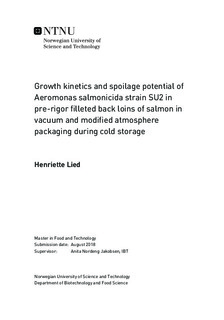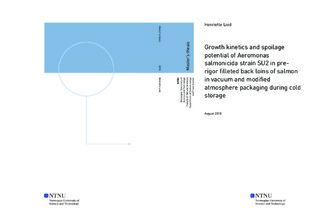| dc.description.abstract | Aeromonas spp. are ubiquitous bacteria in all environments and can easily be isolated from aquatic habitats. They have frequently been isolated from seafood and present a potentially food spoilage and food safety hazard in ready-to-eat seafood because of their ability to grow in a relatively wide range of temperatures including refrigerated storage. However, there is a limited knowledge about the growth and spoilage potential of Aeromonas salmonicida in cold water fish species and under various environmental conditions.
The aim of this study was to assess growth kinetics and the spoilage potential of A. salmonicida SU2 in vacuum packaging and modified atmosphere packaging (CO2:N2 40:60) on pre-rigor filleted back loins of salmon stored at 4 and 8C. A challenge study was conducted to examine growth kinetics of A. salmonicida. Eleven fish metabolites including amino acids, sugars, biogenic amines as well as different products of the ATP degradation process were quantified by nuclear magnetic resonance (NMR).
The results showed that the inoculated strain of A. salmonicida was capable of growth in both vacuum packaging and in MAP at both storage temperatures. The maximum growth rate of A. salmonicida was approximately 3x higher at 8C than at 4C in both vacuum and MAP salmon. However, the lag-phases were generally longer in modified atmosphere. In addition, the results demonstrated the effect of MAP, resulting in a 2-fold decrease in the growth rate of A. salmonicida at 4C compared to vacuum. Generally, the growth rate increased under vacuum packaged conditions for all samples. The data from NMR analysis showed a general increase in the formation of undesired biogenic amines at higher temperatures and at vacuum packaging compared to MAP.
The overall results showed that growth of A. salmonicida is highly affected by temperature, and it demonstrated that refrigeration (4C) and MAP are hurdles to inhibit growth of A. salmonicida and to reduce spoilage on pre- rigor fileted back loins of salmon. However, more studies are needed to elucidate the actual role of A. salmonicida as a spoilage organism in vacuum packed and MAP salmon. | |

